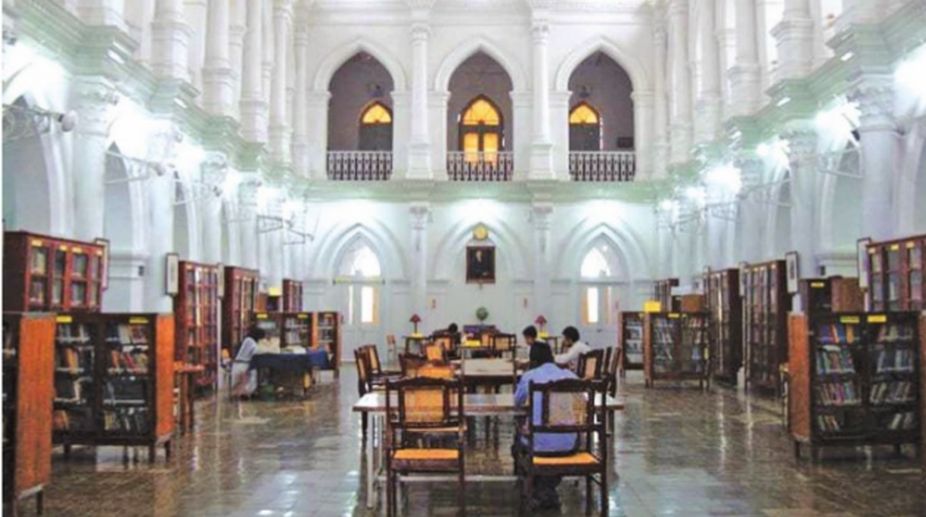Recently on a trip to Bahawalpur, the city of palaces, I got a chance to visit the stately Sadiq Reading Library, also known as the Bahawalpur Central Library, a monument of the Raj era. The architecture is firmly British colonial style, though visitors tend to overlook it. The foundation stone of the library was laid on 8 March 1924 by Sir Rufus Daniel Issacs, the Earl of Reading, who was also the viceroy and governor-general of India, and the Amir of Bahawalpur.
Back then, Bahawalpur State was ruled by Nawab Sir Sadiq Muhammad Khan V and was one of the wealthiest princely states in the Raj – prominent enough for even Queen Victoria to have visited. The state was later the biggest donor of funds and property when Pakistan was created and finally acceded in 1951. Nonetheless, once the foundation stone was laid, the people of Bahawalpur contributed 100,000 rupees for its construction. Currently, the library is under the care of the Punjab government and is the second biggest library in the province. While the temperature outside reached a sweltering 35oC, the inside of the building offered a cooling respite from the summer heat of this desert town.
One is automatically forced to look up in order to grasp the enormous size of the library and the sheer volume of books neatly stacked all over the place. As you browse around, you get drawn into this wave of history – thanks to the walls adorned with the portraits of all the Nawabs of Bahawalpur and other major figures of the Pakistan Movement. Each portrait is accompanied by a brief biography of the worthy individual.
With more than 100,000 books and well over 15,000 active members, the well-stocked library is a world unto itself. Apart from the main hall, there are two other sections: children's books and an audio visual archive. Among the most prized possessions of the library are early editions of Dawn and Pakistan Times – the two newspapers founded by Quaid-i-Azam Mohammad Ali Jinnah. Then there are well-preserved copies of the Holy Quran in beautiful calligraphic styles, some dating back over a century.There are also some Quranic verses on deer hides; these relics are attributed to Imam Husain. The first editions of travelogues of European travellers going back over two centuries have also been preserved here, as have the Persian editions of Diwan-i-Hafiz, Shahnameh Firdousi, and works by Maulana Rumi. Other rare gems include early editions of Punch, or The London Charivari – a satirical British weekly magazine – the very publication that gave the modern usage of the term cartoon.
Unfortunately, one feels a sense of stagnation at the library, primarily because most of the books are well over 30 years old and there are barely any new stocks. There are some new books on the upper level but usually the area is out of bounds for visitors. A caretaker at the library laments that most people coming to the library were there to prepare for exams and rarely was anyone there simply for the joy of reading.
On the way out, near the entrance on the right, is a small hall which houses tiny booths. The caretaker explains that the booth was set up for research scholars: lock yourself in one of these and you are simply far from the maddening crowd. Right next to the Sadiq Reading Library is the Bahawalpur Museum. Near its entrance is an old Vulcan Foundry locomotive painted in black silver and green. A few years ago, the rusty locomotive was rescued by the Bahawalpur Museum and eventually 'rehabilitated'. Not much is known about its history but the museum staff says it was used by the Nawab Sahab. A bogey used by the nawab is rusting away at the hauntingly beautiful but decaying Sadiq Garh Palace in Dera Nawab, along with many vintage cars. The Bahawalpur Museum has been undergoing renovation and rehabilitation for quite some time now.The main entrance is closed due to repair works while a dusty doorway serves as an alternate – giving one no clue as to whether the museum is open or not.
Unlike the well-stocked Lahore Museum, this place is small. Walking around it is like walking through a Pakistan Studies textbook. Of the eight galleries featured here, one focuses solely on the Pakistan Movement. The Gandhara gallery features plenty of replicas which are of interest to history and archaeology enthusiasts.
Another gallery houses items from the personal collection of the nawabs of Bahawalpur including swords, shield bows and arrows, knives, battle armour from the days of the Mughals, old flintlock muskets and three canons.
Within the Bahawalpur Museum lies one of the darkest secrets of Pakistan – a cycle rickshaw. Not many from the younger generation know of this mode of transportation that has been called 'colonial', 'primitive', 'slavery' and 'an affront to human dignity.' For decades, the cycle rickshaw remained a much cheaper mode of transport as compared to the horse drawn tanga (tonga) and later the rickshaws. Imagine pulling a weight of 120kg at least (that's two people in the cart) in the desert, with the merciless sun beating down on you and getting a paltry sum of 10 rupees per trip. This was the cost of a ride from Bahawalpur Station to Lari Adda (bus station) back in the early '90s. In 1992, the government stopped the use of this vehicle. This is around the time when the yellow cab scheme was launched. Outside the Bahawalpur Station, where the maximum number of cycle rickshaws was found, are now many metro cabs and private rental cars. Thankfully this symbol of human oppression is now confined to the museum.
Dawn/ ANN










